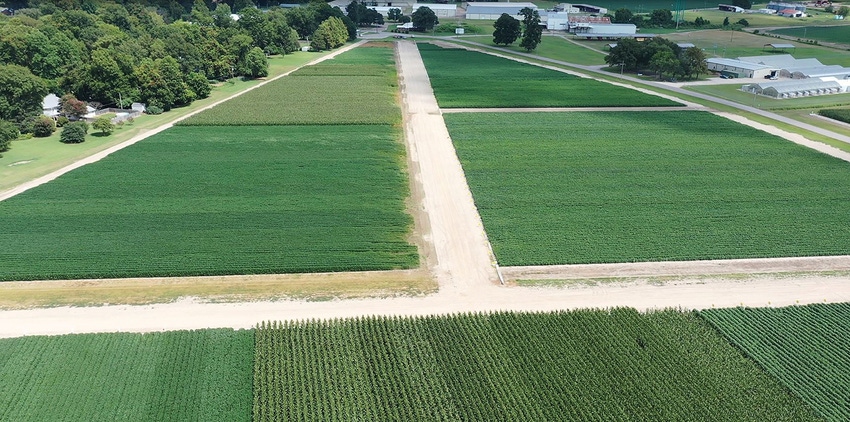
Decisions made at planting time are critical for the development of a good corn crop, according to Jay Mahaffey, manager of the Scott Learning Center in Scott, Miss.
"The planting of corn is a very high precision, precise operation that needs to be done in a very particular way," said Mahaffey. "Because with corn, you get one chance."
It is really about sound agronomics and good decision making, he notes. He has taken a keen interest in the process because the psychology of planting corn is so different from cotton production, in which he worked from many years.
"There are seven or eight things that you do prior to or during the planting process that determines the yield potential of the corn crop. That makes planning and preparation very important."
Agronomically, those decisions that are made at planting time can not be changed or altered to push forward a better yield like they can in other crops like cotton or soybeans.
According to a multi-year study that has taken place onsite at the learning center with DEKALB products, Mahaffey said that it is important to consider row configuration, hybrid traits, seed technology, seed treatments, planting depth, plant population and planting uniformity a head of time to optimize the crop.
"Those decisions that you make prior to or during the planting process cannot be changed after you plant," he said.
Corn that is not uniformly planted at the proper population cannot compensate for the errors made at that time. Those errors can include low plant populations, skips made by the planter and non-uniform emergence.
Field plots at the Learning Center. (courtesy The Scott Learning Center)
Yield can also be determined by hybrid and trait selection, seed spacing and seed treatments, as well as planting configuration - single row/twin row, beds/flat planted - so it's important to talk to someone about how the variety performs in a particular environment. Seed company reps, Extension service, crop consultants and fellow growers are good resources for information on how a select variety best performs in a particular environment.
When producers get into their fields they should do whatever they need to do to adjust the planter appropriately and correctly to avoid skips. Skips are lost revenue and according to Mahaffey, one of the worst things that can happen during planting.
Deeper seed depths
He also notes that seed depth is a critical choice.
"Planting depth can only be established at planting, and it can't be redone without starting over completely," he said
He notes that starting over means additional costs for new seed, additional fuel and more time. All plants should come up at the same time, or as close to the same time as possible.
"Planting depth is one thing that helps us control that," said Mahaffey. "We aim at the learning center, which is a very specific environment, to be two inches deep all the time."
He said that corn producers must adjust to field conditions and understand what the planter is doing and how those conditions – speed, row configuration, soil condition – can affect your planter.
"If you plan a twin row crop and you're off the peak of the bed, that means you probably need to adjust depth down," he said.
He also noted that speed can influence seed depth. A high-tech hydraulic planter can ensure a more uniform seed depth than an old planter run at higher speeds.
But, Mahaffey explains that the two inch depth is hard for some growers who have been planting at a more shallow depth for a long time to accept.
"Sometimes, to tell a long-term grower to plant something two inches deep is very, very uncomfortable for them," he said. "But it's absolutely the right thing to do in corn generally speaking."
He notes that the beauty of planting at a two-inch depth is that the soil buffers most things including temperature. A deeper depth can put the entire planting at a more uniform temperature throughout the field so that when the plant emerges, everything comes up uniformly.
Proper drainage
Mahaffey has run several evaluations of row configuration. In the middle Delta most corn should be planted on beds to allow for adequate drainage, which is necessary for maximum yield potential.
Poor drainage can hamper stand establishment due to soil saturation and can result in a stand that is not uniform throughout.
He notes that last year some of the corn suffered because it was forced to be late planted due to wet, cold weather. Typical planting dates for corn should be March 10 through May 20.
Many growers were forced to plant late or not at all because of moisture that sat in the field last year.
"When it's this flat and no fall in the drainage, if you get a wet spring, you're in a real bind," he said.
His evaluations of row configuration from the learning center can help growers assess their need for particular varieties in various locations and soils
Replant
Mahaffey points out that fields should be carefully evaluated for replanting after emergence and issues corrected at once if they exist.
"The worst thing that can happen in corn is you put it in the ground, it warms up to between 50 and 60 degrees and then imbibes cold water in a rainfall event. Then you get all kinds of bad things happen and it never does well past that," he said.
If a replant is necessary, in most cases he said that it's better to replant an entire field rather than come in over the top of the first planting. Once again, this is to ensure a uniform stand.
"If something happens and you go out there and see you're missing 10% of the plants, you're missing 10% of the yield potential," he said. "If you can live with that loss fine. But, if you feel like you need to start over and drive toward those higher ultimate levels, it's time to start over."
Mahaffey's work at the Scott Learning Center is used to help growers increase the efficiency of their individual operations through advanced agronomic studies, summaries of which are available to growers.
About the Author(s)
You May Also Like






